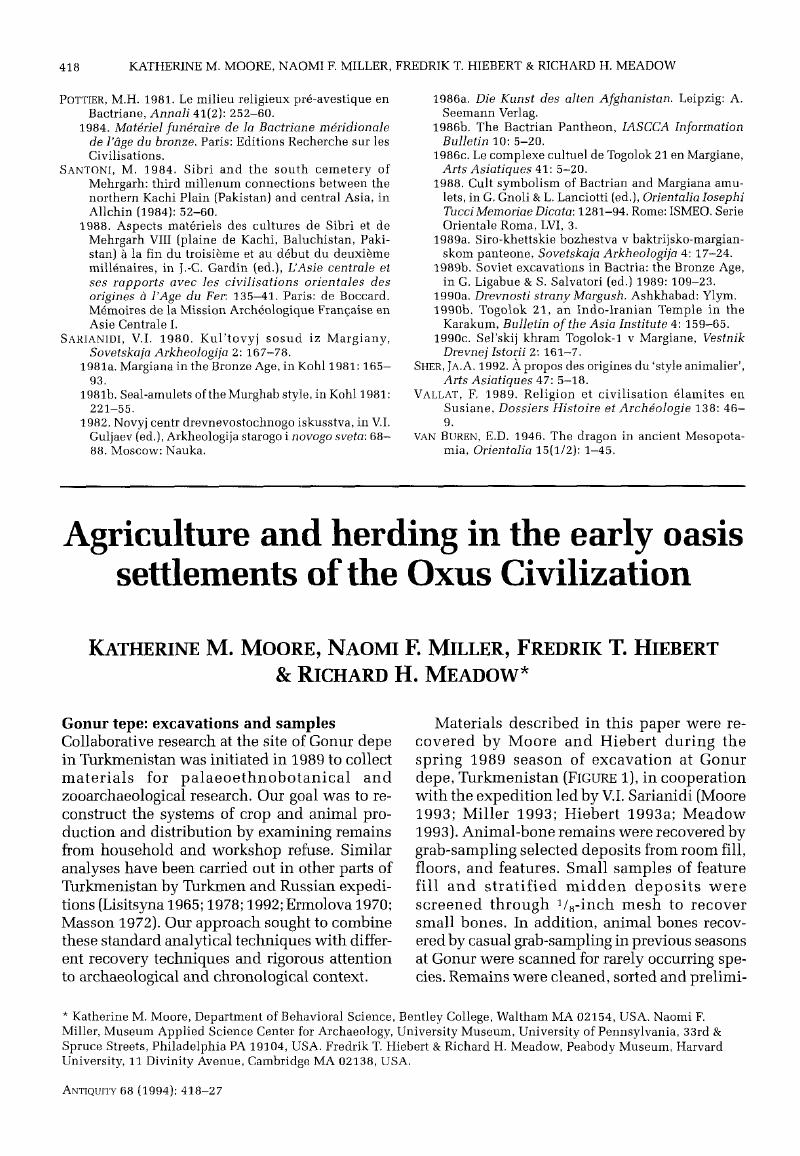Crossref Citations
This article has been cited by the following publications. This list is generated based on data provided by Crossref.
Chen, Kwang -tzuu
and
Hiebert, Fredrik T.
1995.
The late prehistory of xinjiang in relation to its neighbors.
Journal of World Prehistory,
Vol. 9,
Issue. 2,
p.
243.
Simpson, St John
1995.
Fredrik Talmage Hiebert. Origins of the bronze age oasis civilization in central Asia. (American School of Prehestoric Research Bulletin 42.) xxxviii+200 pages, 169 illustrations, 13 tables. 1994. Cambridge (MA): Harvard University, Peadbody Museum of Archaeology and Ethnology; 0-87365-545-1 paperback $40.
Antiquity,
Vol. 69,
Issue. 266,
p.
1070.
Hiebert, Fredrik T.
and
Shishlina, Natalia I.
1996.
Introduction.
Anthropology & Archeology of Eurasia,
Vol. 34,
Issue. 4,
p.
5.
Kroll, Helmut
1996.
Literature on archaeological remains of cultivated plants (1994/95).
Vegetation History and Archaeobotany,
Vol. 5,
Issue. 1-2,
p.
169.
Peters, Joris
and
Driesch, Angela von den
1997.
The two‐humped camel (Camelus bactrianus): new light on its distribution, management and medical treatment in the past.
Journal of Zoology,
Vol. 242,
Issue. 4,
p.
651.
Hastorf, Christine A.
1999.
Recent research in paleoethnobotany.
Journal of Archaeological Research,
Vol. 7,
Issue. 1,
p.
55.
Frachetti, Michael D.
Spengler, Robert N.
Fritz, Gayle J.
and
Mar'yashev, Alexei N.
2010.
Earliest direct evidence for broomcorn millet and wheat in the central Eurasian steppe region.
Antiquity,
Vol. 84,
Issue. 326,
p.
993.
Zaharieva, Maria
Ayana, Negash Geleta
Hakimi, Amin Al
Misra, Satish C.
and
Monneveux, Philippe
2010.
Cultivated emmer wheat (Triticum dicoccon Schrank), an old crop with promising future: a review.
Genetic Resources and Crop Evolution,
Vol. 57,
Issue. 6,
p.
937.
VanDerwarker, Amber M.
and
Peres, Tanya M.
2010.
Integrating Zooarchaeology and Paleoethnobotany.
p.
1.
Markofsky, Steven
2012.
Harris, D., Origins of Agriculture in Western Central Asia. An Environmental-Archaeological Study. Philadelphia, University of Pennsylvania Press, 2010, XVI+304 p., 8 color plates, ISBN 978-1-934536-16-2..
Ancient Civilizations from Scythia to Siberia,
Vol. 18,
Issue. 1,
p.
183.
Aubaile, Françoise
2012.
Pathways of diffusion of some plants and animals between Asia and the Mediterranean region.
Revue d’ethnoécologie,
2012.
A Companion to the Archaeology of the Ancient Near East.
p.
1117.
Frachetti, Michael D.
2012.
Multiregional Emergence of Mobile Pastoralism and Nonuniform Institutional Complexity across Eurasia.
Current Anthropology,
Vol. 53,
Issue. 1,
p.
2.
Spengler, Robert N
Frachetti, Michael D.
and
Fritz, Gayle J.
2013.
Ecotopes and Herd Foraging Practices In the Steppe/Mountain Ecotone of Central Asia During the Bronze and Iron Ages.
Journal of Ethnobiology,
Vol. 33,
Issue. 1,
p.
125.
Cleary, Michelle Negus
2013.
Khorezmian Walled Sites of the Seventh Century Bc—Fourth Century Ad: Urban Settlements? Elite Strongholds? Mobile Centres?.
Iran,
Vol. 51,
Issue. 1,
p.
71.
Spengler, Robert N.
Chang, Claudia
and
Tourtellotte, Perry A.
2013.
Agricultural production in the Central Asian mountains: Tuzusai, Kazakhstan (410–150b.c.).
Journal of Field Archaeology,
Vol. 38,
Issue. 1,
p.
68.
Spengler, Robert N.
and
Willcox, George
2013.
Archaeobotanical results from Sarazm, Tajikistan, an Early Bronze Age Settlement on the edge: Agriculture and exchange.
Environmental Archaeology,
Vol. 18,
Issue. 3,
p.
211.
Spengler, Robert N.
Cerasetti, Barbara
Tengberg, Margareta
Cattani, Maurizio
and
Rouse, Lynne M.
2014.
Agriculturalists and pastoralists: Bronze Age economy of the Murghab alluvial fan, southern Central Asia.
Vegetation History and Archaeobotany,
Vol. 23,
Issue. 6,
p.
805.
d’Alpoim Guedes, Jade
Lu, Hongliang
Li, Yongxian
Spengler, Robert N.
Wu, Xiaohong
and
Aldenderfer, Mark S.
2014.
Moving agriculture onto the Tibetan plateau: the archaeobotanical evidence.
Archaeological and Anthropological Sciences,
Vol. 6,
Issue. 3,
p.
255.
Spengler, Robert
Frachetti, Michael
Doumani, Paula
Rouse, Lynne
Cerasetti, Barbara
Bullion, Elissa
and
Mar'yashev, Alexei
2014.
Early agriculture and crop transmission among Bronze Age mobile pastoralists of Central Eurasia.
Proceedings of the Royal Society B: Biological Sciences,
Vol. 281,
Issue. 1783,
p.
20133382.



